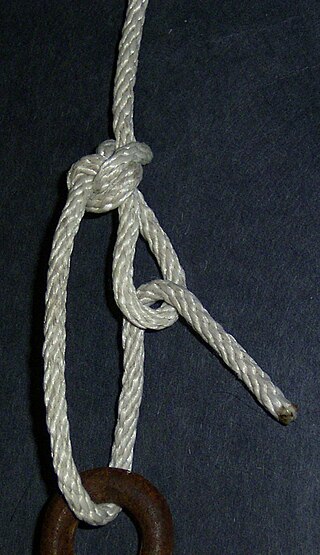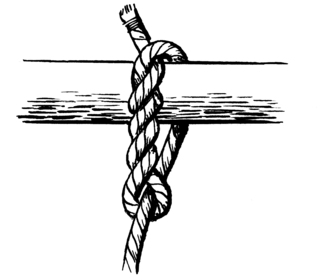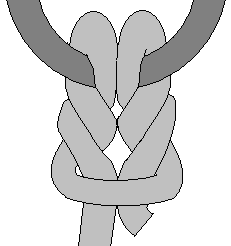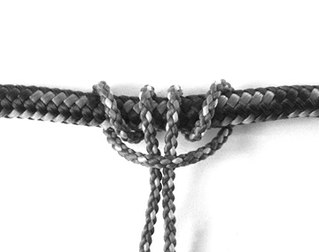
A knot is an intentional complication in cordage which may be practical or decorative, or both. Practical knots are classified by function, including hitches, bends, loop knots, and splices: a hitch fastens a rope to another object; a bend fastens two ends of a rope to each another; a loop knot is any knot creating a loop; and splice denotes any multi-strand knot, including bends and loops. A knot may also refer, in the strictest sense, to a stopper or knob at the end of a rope to keep that end from slipping through a grommet or eye. Knots have excited interest since ancient times for their practical uses, as well as their topological intricacy, studied in the area of mathematics known as knot theory.

The bowline is an ancient and simple knot used to form a fixed loop at the end of a rope. It has the virtues of being both easy to tie and untie; most notably, it is easy to untie after being subjected to a load. The bowline is sometimes referred to as King of the knots because of its importance. Along with the sheet bend and the clove hitch, the bowline is often considered one of the most essential knots.

The constrictor knot is one of the most effective binding knots. Simple and secure, it is a harsh knot that can be difficult or impossible to untie once tightened. It is made similarly to a clove hitch but with one end passed under the other, forming an overhand knot under a riding turn. The double constrictor knot is an even more robust variation that features two riding turns.

A shank is a type of knot that is used to shorten a rope or take up slack, such as the sheepshank. The sheepshank knot is not stable. It will fall apart under too much load or too little load.

The clove hitch is an ancient type of knot, made of two successive single hitches tied around an object. It is most effectively used to secure a middle section of rope to an object it crosses over, such as a line on a fencepost. It can also be used as an ordinary hitch, or as a binding knot, but it is not particularly secure in either application. It is considered one of the most important knots, alongside the bowline and the sheet bend.
Although the name clove hitch is given by Falconer in his Dictionary of 1769, the knot is much older, having been tied in ratlines at least as early as the first quarter of the sixteenth century. This is shown in early sculpture and paintings. A round turn is taken with the ratline and then a hitch is added below. The forward end is always the first to be made fast.

The trucker's hitch is a compound knot commonly used for securing loads on trucks or trailers. The general arrangement, using loops and turns in the rope itself to form a crude block and tackle, has long been used to tension lines and is known by multiple names. Knot author Geoffrey Budworth claims the knot can be traced back to the days when carters and hawkers used horse-drawn conveyances to move their wares from place to place.

The taut-line hitch is an adjustable loop knot for use on lines under tension. It is useful when the length of a line will need to be periodically adjusted in order to maintain tension. It is made by tying a rolling hitch around the standing part after passing around an anchor object. Tension is maintained by sliding the hitch to adjust the size of the loop, thus changing the effective length of the standing part without retying the knot.

The timber hitch is a knot used to attach a single length of rope to a cylindrical object. Secure while tension is maintained, it is easily untied even after heavy loading.

The Cat's paw is a knot used for connecting a rope to an object. It is very similar to the cow hitch except there is an additional twist on each side of the bight, making it less prone to slipping.
The cat's-paw is the common hook hitch for slings. It is the same basic form as the bale sling hitch but has additional twists. Brady says "two or three altogether," and Steel, who mentioned the name in 1794, says "three twists." It is the best of all sling hitches and is often recommended for a slippery rope. But no hitch can slip when tied in a slings since it has no ends. All that is needed is a hitch that cannot jam, and this requirement the cat's-paw fills admirably. The knot spills instantly when removed from the hook. It is the hitch always used for heavy lifts.

The Munter hitch, also known as the Italian hitch, mezzo barcaiolo or the crossing hitch, is a simple adjustable knot, commonly used by climbers, cavers, and rescuers to control friction in a life-lining or belay system. To climbers, this hitch is also known as HMS, the abbreviation for the German term Halbmastwurfsicherung, meaning half clove hitch belay. This technique can be used with a special "pear-shaped" HMS locking carabiner, or any locking carabiner wide enough to take two turns of the rope.

The half hitch is a simple overhand knot, where the working end of a line is brought over and under the standing part. Insecure on its own, it is a valuable component of a wide variety of useful and reliable hitches, bends, and knots.
The half hitch is tied with one end of a rope which is passed around an object and secured to its own standing part with a single hitch.

The buntline hitch is a knot used for attaching a rope to an object. It is formed by passing the working end around an object, then making a clove hitch around the rope's standing part and taking care that the turns of the clove hitch progress towards the object rather than away from it. Secure and easily tied, the buntline hitch will jam when subjected to extreme loads. Given the knot's propensity to jam, it is often made in slipped form.
The buntline hitch, when bent to a yard, makes a more secure knot than two half hitches, but is more liable to jam. It differs from two half hitches in that the second half hitch is inside instead of outside the first one.

The adjustable grip hitch is a simple and useful friction hitch which may easily be shifted up and down the rope while slack. It will hold fast when loaded, but slip when shock loaded until tension is relieved enough for it to again hold fast. It serves the same purpose as the taut-line hitch, e.g. tensioning a tent's guy line.

A Prusik is a friction hitch or knot used to attach a loop of cord around a rope, applied in climbing, canyoneering, mountaineering, caving, rope rescue, ziplining, and by arborists. The term Prusik is a name for both the loops of cord used to tie the hitch and the hitch itself, and the verb is "to prusik". More casually, the term is used for any friction hitch or device that can grab a rope. Due to the pronunciation, the word is often misspelled Prussik, Prussick, or Prussic.
The magnus hitch is a knot similar to a rolling hitch or clove hitch, used to tie a rope or line to a pole, spar, or another line. It is tied similarly to a rolling hitch but with the final hitch in the opposite direction. It can be more tricky to snug up, since both lines emerge from the same side of the hitch, but it has less tendency to twist under load.

The highpoint hitch is a type of knot used to attach a rope to an object. The main feature of the hitch is that it is very secure, yet if tied as a slipped knot it can be released quickly and easily with one pull, even after heavy loading. The highpoint hitch is tied in the same manner as a slipped buntline hitch until the final turn, where they diverge.

The gripping sailor's hitch is a secure, jam-proof friction hitch used to tie one rope to another, or a rope to a pole, boom, spar, etc., when the pull is lengthwise along the object. It will even grip a tapered object, such as a marlin spike, in the direction of taper, similar to the Icicle hitch, and it is much superior to the rolling hitch for that purpose.

Swing hitch is a way to tie a swing rope to a branch or other horizontal beam. Ashley describes it in ABOK as "... firm, strong, secure, and easily untied once the load has been removed."





















